The NVIDIA Titan V Preview - Titanomachy: War of the Titans
by Ryan Smith & Nate Oh on December 20, 2017 11:30 AM ESTPower, Temperature, & Noise
Finally, let's talk about power, temperature, and noise. At a high level, the Titan V should not be substantially different from other high-end NVIDIA cards. It has the same 250W TDP, and the cooler is nearly identical to NVIDIA’s other vapor chamber cooler designs. In short, NVIDIA has carved out a specific niche on power consumption that the Titan V should fall nicely into.
Unfortunately, no utilities seem to be reporting voltage or HBM temperature of Titan V at this time. These would be particularly of interest considering that Volta is fabbed on TSMC's bespoke 12FFN as opposed to 16nm FinFET. This also marks the first time NVIDIA has implemented HBM2 in gaming use-cases, where HBM temperatures or voltages could be elucidating.
| NVIDIA Titan V and Xp Average Clockspeeds | |||
| NVIDIA Titan V | NVIDIA Titan Xp | Percent Difference | |
| Idle | 135MHz | 139MHz | - |
| Boost Clocks |
1455MHz
|
1582MHz
|
-8.0% |
| Max Observed Boost |
1785MHz
|
1911MHz
|
-6.6% |
| LuxMark Max Boost | 1355MHz | 1911MHz | -29.0% |
| Battlefield 1 |
1651MHz
|
1767MHz
|
-6.6% |
| Ashes: Escalation |
1563MHz
|
1724MHz
|
-9.3% |
| DOOM |
1561MHz
|
1751MHz
|
-10.9% |
| Ghost Recon |
1699MHz
|
1808MHz
|
-6.0% |
| Deus Ex (DX11) |
1576MHz
|
1785MHz
|
-11.7% |
| GTA V |
1674MHz
|
1805MHz
|
-7.3% |
| Total War (DX11) | 1621MHz | 1759MHz | -7.8% |
| FurMark |
1200MHz
|
1404MHz
|
-14.5% |
Interestingly, LuxMark only brings Titan V to 1355MHz instead of its maximum boost clock, a behavior that differs from every other card we've benched in recent memory. Other compute and gaming tasks do bring the clocks higher, with a reported peak of 1785MHz.
The other takeaway is that Titan V is consistently outclocked by Titan Xp. In terms of gaming, Volta's performance gains do not seem to be coming from clockspeed improvements, unlike the bulk of Pascal's performance improvement over Maxwell.
Meanwhile it's worth noting that the HBM2 memory on the Titan V has only one observed clock state: 850MHz. This never deviates, even during FurMark as well as extended compute or gameplay. For the other consumer/prosumer graphics cards with HBM2, AMD's Vega cards downclock HBM2 in high temperature situations like FurMark, and also features a low-power 167MHz idle state.
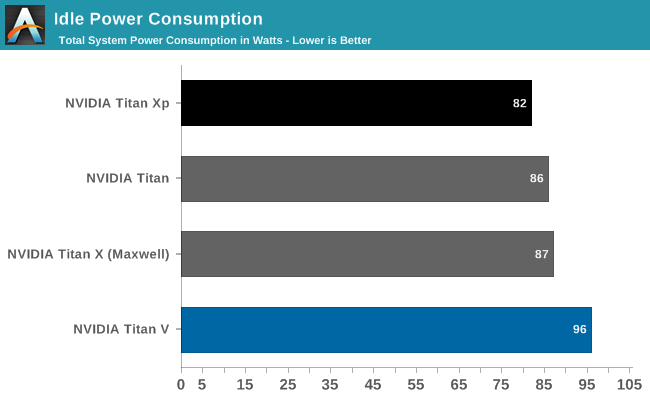
Measuring power from the wall, Titan V's high idle and lower load readings jump out.
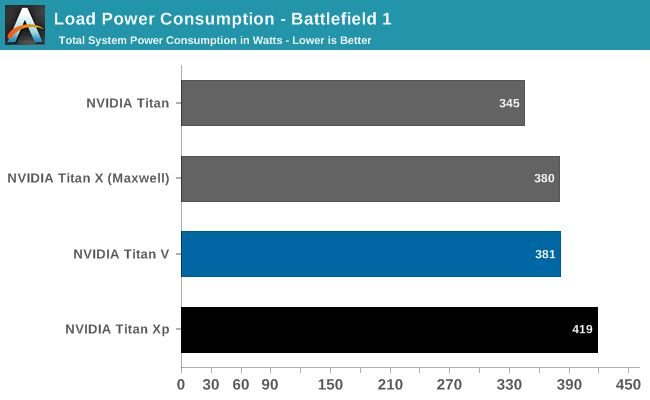
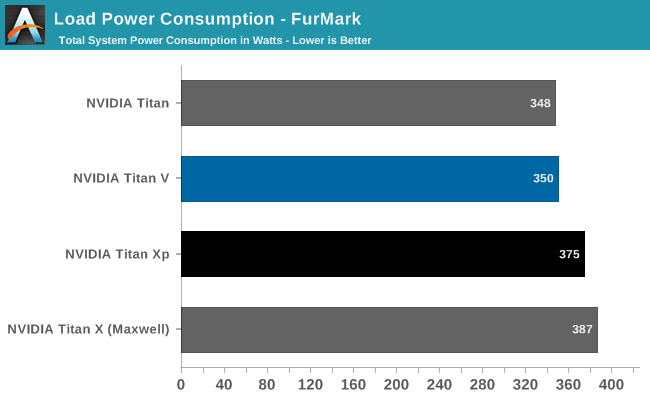
Meanwhile under load, the Titan V's power consumption at the wall is slightly but consistently lower than the Titan Xp's. Again despite the fact that both cards have the same TDPs, and NVIDIA's figures tend to be pretty consistent here since Maxwell implemented better power management.

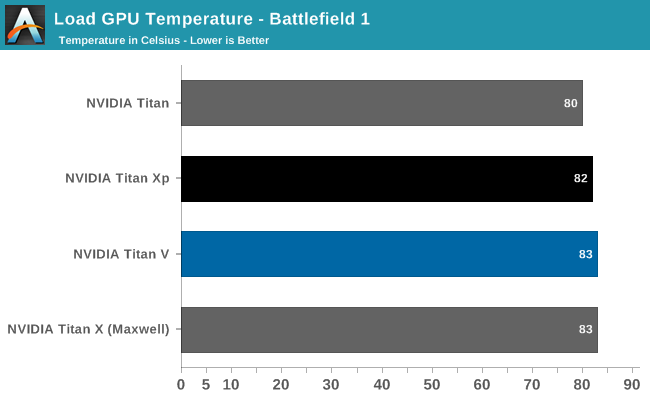
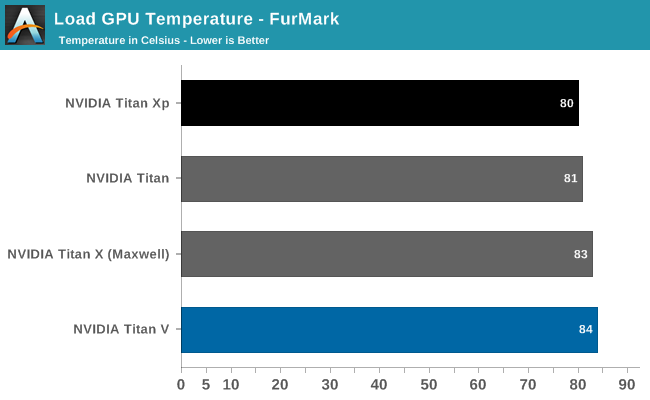
During the course of benchmarking, GPU-Z reported a significant amount of Titan V thermal throttling, and that continued in Battlefield 1, where it oscillated between being capped out by GPU underutilization and temperature. And in FurMark, the Titan V was consistently temperature-limited.
Without HBM2 voltages, it is hard to say if the constant 850MHz clocks are related to Titan V's higher idle system draw. 815mm2 is quite large, but then again elements like Volta's tensor cores are not being utilized in gaming. In Battlefield 1, system power draw is actually lower than Titan Xp but GPU Z would suggest that thermal limits are the cause. Typically what we've seen with other NVIDIA 250W TDP cards is that they hit their TDP limits more often than they hit their temperature limits. So this is an unusual development.
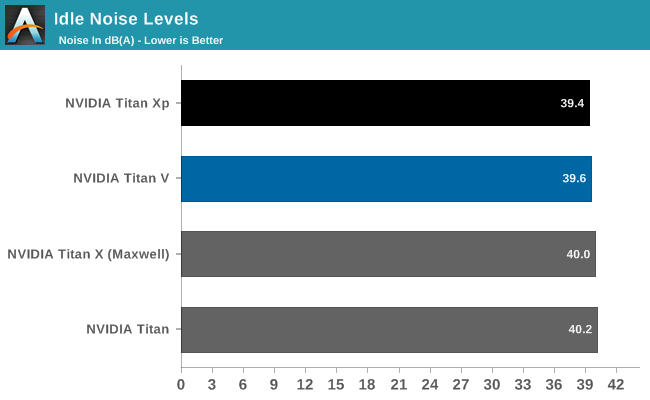
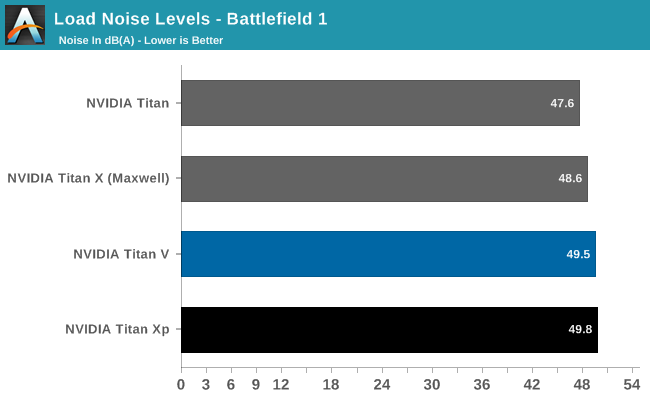
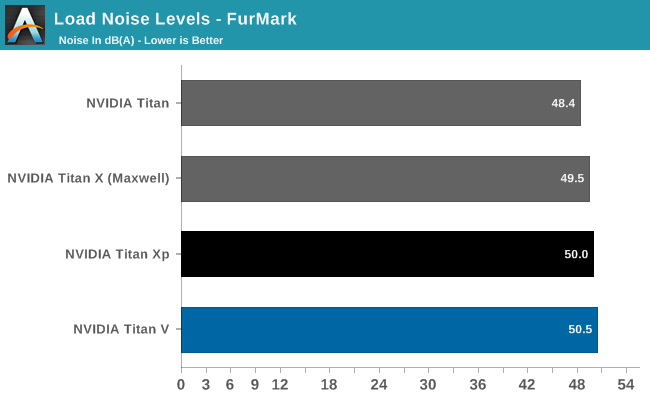
Featuring an improved cooler, Titan V essentially manages the same noise metrics as its Titan siblings.










111 Comments
View All Comments
praktik - Wednesday, December 20, 2017 - link
Actually probably both XP and V could run 4k Crysis pretty well - do we need 4xssaa @ 4k??Ryan Smith - Wednesday, December 20, 2017 - link
"do we need 4xssaa"If it were up to me, the answer to that would always be yes. Jaggies suck.
tipoo - Wednesday, December 20, 2017 - link
Do they plan on exposing fast FP16 in software? When consumer Volta launches maybe?Ryan Smith - Wednesday, December 20, 2017 - link
Nothing has been announced at this time.Keldor314 - Wednesday, December 20, 2017 - link
The part of the article about Volta no longer having a superscalar architecture is incorrect. Although there is only one warp scheduler per SM partition (what do you call those things anyway?), each clock cycles only serves half a warp, so it takes two clock cycles for an instruction to feed into one of the execution pipelines, but during the second cycle, the warp schedular is free is issue a second instruction to one of the other pipelines. IIRC, Fermi did this too.mode_13h - Wednesday, December 27, 2017 - link
Also, the part about per-thread PC and Stack is misleading. Warps are still executing (or not executing) from a single instruction sequence. The threads within a warp are not concurrently executing different instructions, nor are threads being dynamically shuffled between different warps - at least, not at a hardware level.MrSpadge - Wednesday, December 20, 2017 - link
> Sure, compute is useful. But be honest: you came here for the 4K gaming benchmarks, right?Actually, no: I came for compute, power and voltage.
jabbadap - Wednesday, December 20, 2017 - link
Interesting, so it have full floating point compute capabilities 1*fp64 -> 2*fp32 -> 4*fp16 + Tensor cores. But that half precision is only for CUDA? So no direct3d 12 minimum floating point precision.Native7i - Wednesday, December 20, 2017 - link
So it looks like V series focused on machine learning and development.Maybe rumors are correct about Ampere replacing Pascal...
extide - Saturday, December 23, 2017 - link
Maybe, I mean GP100 was very different than GP102 on down, so they could do the same thing..